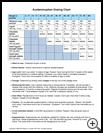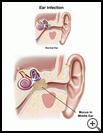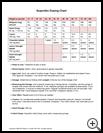
Ear Infection (Otitis Media)
What is an ear infection?
An ear infection is an infection of the middle ear (the space behind the eardrum). It is most often caused by bacteria. It usually is a complication of a cold and starts on the third day of the cold. A cold blocks off the tube that connects the middle ear to the back of the throat (the eustachian tube).
Most children will have at least one ear infection, and over one fourth of these children will have repeated ear infections. Children are most likely to have ear infections between the ages of 6 months and 2 years, but they continue to be a common childhood illness until the age of 8 years.
In 5% to 10% of children, the pressure in the middle ear causes the eardrum to rupture and drain a yellow or cloudy fluid. This small hole usually heals over the next few days.
If the following treatment is carried out your child should be fine. Permanent damage to the ear or to the hearing is very rare.
What are the symptoms?
Your child's ear is painful because trapped, infected fluid puts pressure on the eardrum, causing it to bulge. Other symptoms are irritability and poor sleep. Some children have trouble hearing. A few have dizziness. If the eardrum ruptures (tears), cloudy fluid or pus will drain from the ear canal.
How can I take care of my child?
- Antibiotics (For mild ear infections, antibiotics may not be needed.)
Your child needs the antibiotic prescribed by your healthcare provider. This medicine will kill the bacteria that are causing the ear infection.
Try not to forget any of the doses. If your child goes to school or a baby sitter, arrange for someone to give the afternoon dose. If the medicine is a liquid, store the antibiotic in the refrigerator and use a measuring spoon to be sure that you give the right amount. Give the medicine until the bottle is empty or all the pills are gone. (Do not save the antibiotic for the next illness because it loses its strength.) Even though your child will feel better in a few days, give the antibiotic until it is completely gone. Finishing the medicine will keep the ear infection from flaring up again.
- Pain relief
Acetaminophen or ibuprofen can be used to help with the earache or fever over 102°F (39°C) for a few days until the antibiotic takes effect. These medicines usually control the pain within 1 to 2 hours. Earaches tend to hurt more at bedtime.
To help ease the pain, you can put a cold pack or ice wrapped in a wet washcloth over the ear. This may decrease the swelling and pressure inside. Some providers recommend a heating pad or warm, moist washcloth instead. Remove the cold or heat in 20 minutes to prevent frostbite or a burn.
- Restrictions
Your child can go outside and does not need to cover the ears. Swimming is fine as long as there is no perforation (tear) in the eardrum or drainage from the ear. Children with ear infections can travel safely by aircraft if they are taking antibiotics. Also give them a dose of ibuprofen 1 hour before take-off to deal with any discomfort they might have. Most will not have an increase in their ear pain while flying. While coming down in elevation during a airline flight or a trip from the mountains, have your child swallow fluids, suck on a pacifier, or chew gum.
Your child can return to school or day care when he or she is feeling better and the fever is gone. Ear infections are not contagious.
- Ear recheck
Your child may need to be rechecked by the healthcare provider in 2 to 3 weeks. At that visit, the eardrum will be checked to make sure that the infection is cleared up and no more treatment is needed. Your healthcare provider may also want to test your child's hearing. Follow-up exams are very important if the infection has caused a hole in the eardrum.
How can I help prevent ear infections?
If your child has a lot of ear infections, it's time to look at how you can prevent some of them. If some of the following items apply to your child, try to use them or talk to your healthcare provider about them.
- Protect your child from second-hand tobacco smoke. Passive smoking increases the frequency and severity of infections. Be sure no one smokes in your home or at day care.
- Reduce your child's exposure to colds during the first year of life. Most ear infections start with a cold. Try to delay the use of large day care centers during the first year by using a sitter in your home or a small home-based day care.
- Breast-feed your baby during the first 6 to 12 months of life. Antibodies in breast milk reduce the rate of ear infections. If you're breast-feeding, continue. If you're not, consider it with your next child.
- Give your child all recommended immunizations. The flu vaccine and the pneumococcal vaccine will protect your child from some ear infections.
- Avoid bottle propping. If you bottle-feed, hold your baby with the head higher than the stomach. Feeding in the horizontal position can cause formula to flow back into the eustachian tube. Allowing an infant to hold his own bottle also can cause milk to drain into the middle ear.
- Control allergies. If your infant always has a runny nose, a milk allergy may be the problem. This is more likely if your child has other allergies such as eczema.
- Check for snoring. If your toddler snores every night or breathes through his mouth, he may have large adenoids. Large adenoids can lead to ear infections. Talk to your healthcare provider about this.
When should I call my child's healthcare provider?
Call IMMEDIATELY if:
- Your child develops a stiff neck.
- Your child acts very sick.
Call during office hours if:
- The fever or pain is not gone after your child has taken the antibiotic for 48 hours.
- You have other questions or concerns.
Last modified: 2017-06-05
Last reviewed: 2017-06-05



